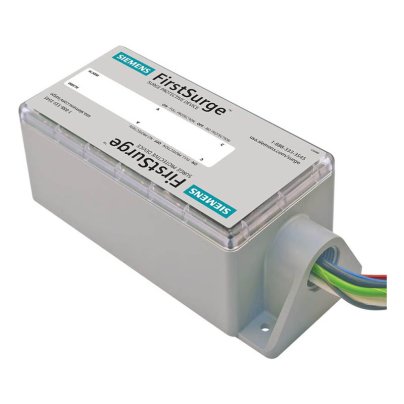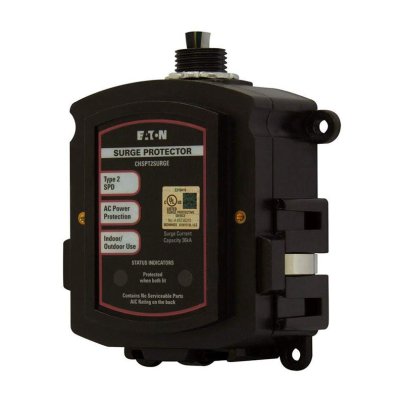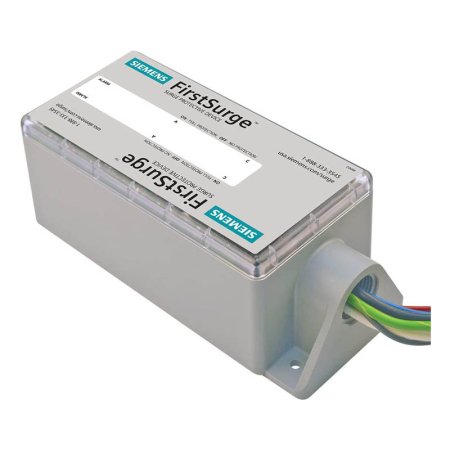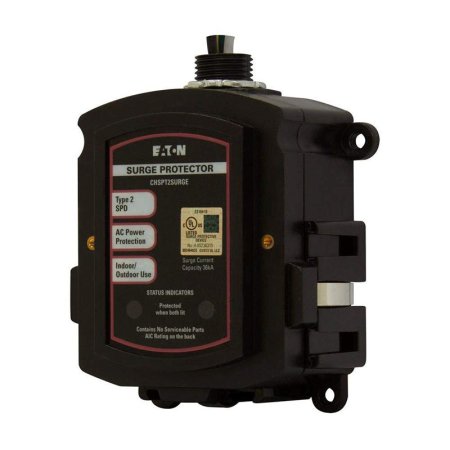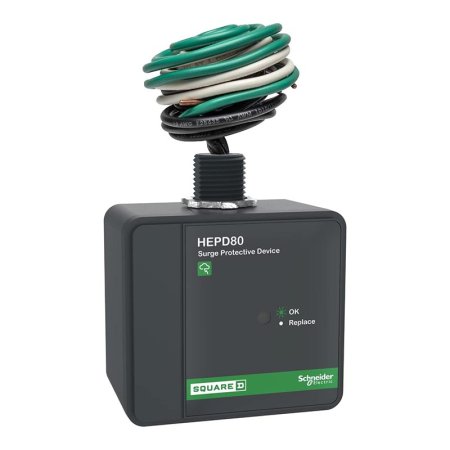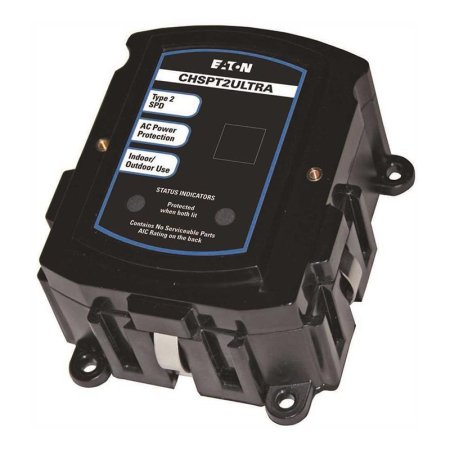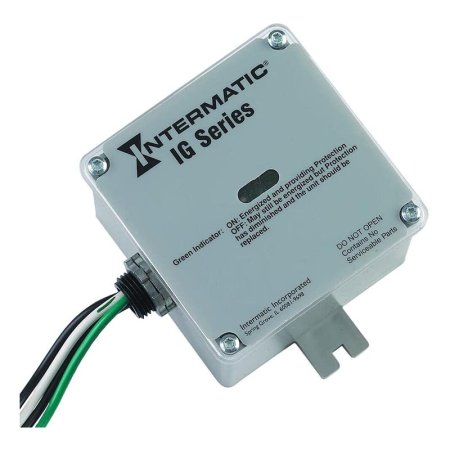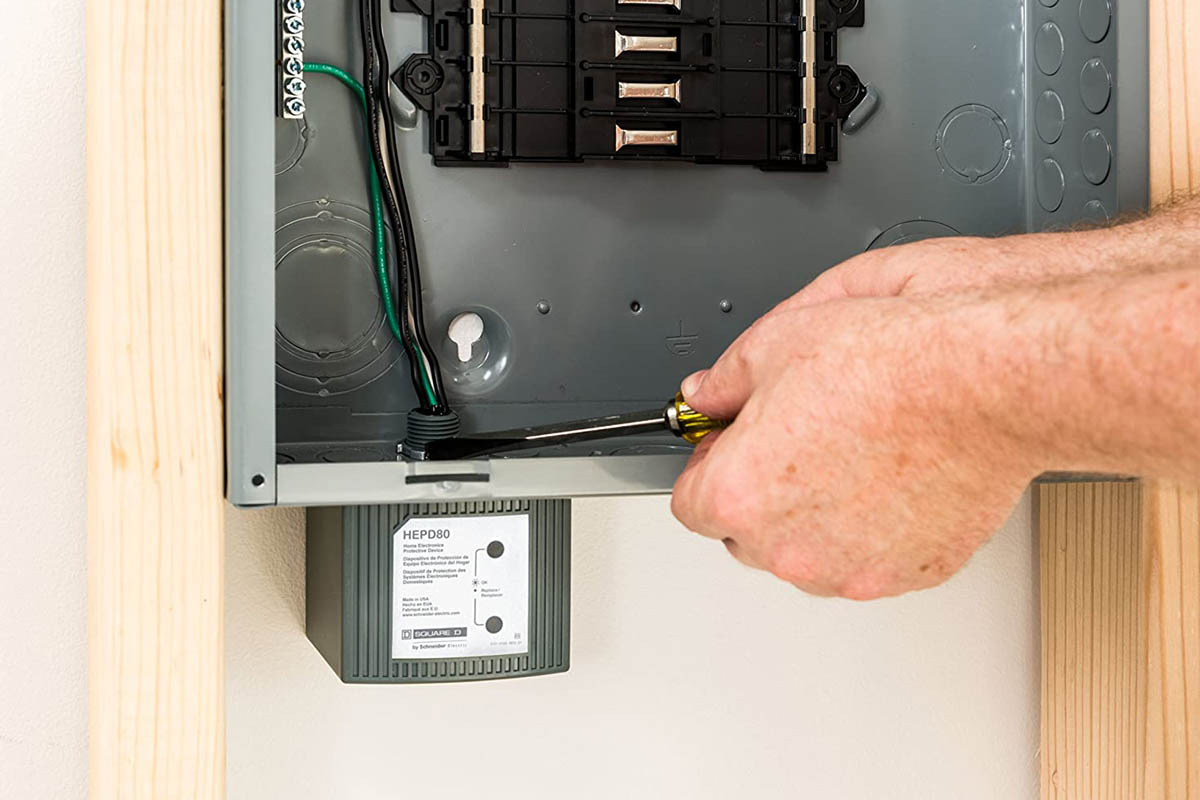
We may earn revenue from the products available on this page and participate in affiliate programs. Learn More ›
Extreme weather conditions like hurricanes, tornadoes, blizzards, and thunderstorms pose obvious power-outage threats. Still, other factors contribute to voltage surges more often than you might realize, which is why most homes should have a whole-house surge protector. Faults or fires in main transformers or generating equipment can disrupt your home’s power supply. Additionally, brownouts, or drops in voltage in an electrical power supply system, often result in a surge as power is restored. These incidents are far from unusual.
Even if a power surge lasts only a fraction of a second, anyone on the receiving end can tell you how dramatic the results can be. Excess electricity can damage technology and electronics, including everything from a computer, TV, or refrigerator to the compressor of an HVAC system. Fortunately, devices to prevent these problems are surprisingly affordable—particularly compared to the cost of replacing damaged items. As an engineer and home remodeler, I have worked with electrical contractors to specify and install them. Through my experience and advice from an expert electrician, I chose the Siemens FirstSurge Plus Whole-House Surge Protector as the best whole-house surge protector for its outstanding 100kA (kiloAmps) protection rating, easy-to-use status signaling, and NEMA (National Electrical Manufacturer Association) 4X rating. Read on to learn more about this model and see the others I recommend. With my top picks, expert insights, and supporting information on which features matter most, you’ll be prepared to choose the best whole-house surge protector for your property.
- BEST OVERALL: Siemens FirstSurge Plus Whole-House Surge Protector
↓ Jump to Review - BEST BANG FOR THE BUCK: Eaton CHSPT2SURGE SPD Type 2 Surge Protector
↓ Jump to Review - BEST MIDRANGE: Schneider Electric Square D HEPD80 Surge Protection
↓ Jump to Review - BEST HEAVY-DUTY: Eaton CHSPT2ULTRA SPD Type 2 Surge Protector
↓ Jump to Review - HONORABLE MENTION: Intermatic IG Series Surge Protective Device
↓ Jump to Review - ALSO CONSIDER: Intermatic Smart Guard Surge Protective Device
↓ Jump to Review
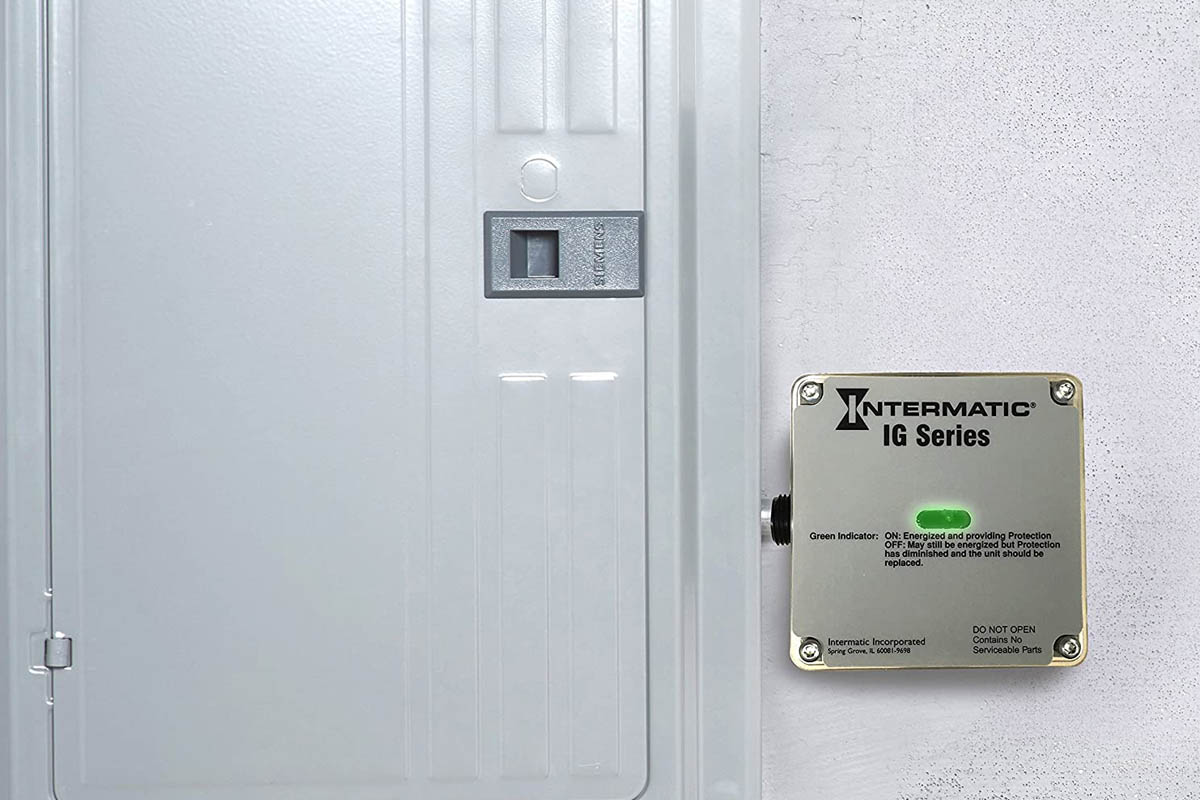
Our Top Picks
If you know the answer to the question, “What is a power surge?” you know why having a surge protector matters. Each of these surge protection devices (SPDs) offers unique features and benefits. Learn more about what we especially like about these models and what we might change below.
Best Overall
Siemens FirstSurge Plus Whole-House Surge Protector
Product Specs
- SPD: Type 2
- Protection rating: 100kA
- NEMA enclosure: Type 4
What We Like
- Offers excellent surge protection for homes and businesses
- Safeguards smart appliances and electronics
- Can be installed indoors or out
What We Don’t Like
- Status lights seem excessively bright
Siemens offers a range of surge-protection devices, and the 100kA model sits between their premium 140kA option and their smaller 60kA unit. For most residential installations and many commercial uses, the FirstSurge Plus will be just right. It comes with a tough thermoplastic NEMA 4X-rated case that can withstand driven rain, windblown dust, and ice formation on the enclosure itself. Multiple fitment options mean it is also suitable for indoors.
Its user-friendly alert system shows a green light for fully operational status and a flashing red plus an audible warning if there has been an overload and the electrical system is not protected. Though the lights seem almost too bright, we’d rather that than the other. Compatible cable and phone devices are also available for more comprehensive coverage, though they cost extra.
Get the Siemens whole-house surge protector at Amazon, Lowe’s, or The Home Depot.
Best Bang for the Buck
Eaton CHSPT2SURGE SPD Type 2 Surge Protector
Product Specs
- SPD: Type 2
- Protection rating: 36kA
- NEMA enclosure: Type 4
What We Like
- Reliable and affordable protection
- NEMA 4-rated to withstand rain and freezing temperatures
- Innovative mount design that fits almost any panel
What We Don’t Like
- Not sufficient for direct lightning strikes
Eaton has built a reputation for reliable and durable equipment at competitive prices, and its CHSPT2SURGE SPD is no exception. This compact unit offers excellent protection in an affordable package, can be installed indoors or out, and is easy to mount thanks to an innovative universal design that can be adapted to almost any panel. Its NEMA 4 case is more than we typically see on a budget surge protector device and is durable enough to protect the internal circuitry from rain, snow, and ice.
The CHSPT2SURGE SPD is Underwriters Laboratories (UL) listed and offers the standard four protection modes. Its LED indicators clearly indicate the status of the unit and its maximum surge protection rating of 36kA. Users will want to be aware that it does not protect against direct lightning strikes.
Get the Eaton CHSPT2SURGE whole-house surge protector at Amazon, The Home Depot, or Walmart.
Best Midrange
Schneider Electric Square D HEPD80 Surge Protector
Product Specs
- SPD: Type 1
- Protection rating: 80kA
- NEMA enclosure: Type 4
What We Like
- Offers whole-home surge protection
- NEMA 4X enclosure can be fitted indoors or out
- Has 6 modes for greater surge dispersal
What We Don’t Like
- Some owners are critical of the warranty claims procedure
This high-quality Type 1 whole-house power surge protector from Schneider Electric offers the ultimate in versatility. The compact unit features a NEMA 4X case, can be installed indoors or out, and is designed to be fitted on the line side of any residential breaker panel. Despite its impressive 80kA protection level, the HEPD80 is still a very affordable option.
Whereas most surge protectors offer four modes of protection (the way the surge is channeled away from the home’s electric devices), the HEPD80 offers six. While this feature is perhaps only of interest to professional electricians, it can increase the margin of safety provided. It is also both UL listed and Canadian Standards Association (CSA) certified.
Get the Schneider Electric whole-house surge protector at Amazon, Lowe’s, or The Home Depot.
Best Heavy-Duty
Eaton CHSPT2ULTRA SPD Type 2 Surge Protector
Product Specs
- SPD: Type 2
- Protection rating: 108kA
- NEMA enclosure: Type 4
What We Like
- Combines high protection with a Type 4 enclosure
- Mounts outside the breaker box for universal use
- Compatible with 120 or 240-volt residential or commercial lines
What We Don’t Like
- Requires a special 50A thermal breaker that costs extra
The Eaton CHSPT2ULTRA is another of this leading brand’s high-quality surge protection devices that won’t break the bank. Like the model we recommend as Best Bang for the Buck, this model has a tough NEMA 4 case that provides all-weather protection, or you can fit it indoors. Because you install this compact SPD outside the breaker box, it can be combined with any manufacturer’s load center.
With single surge protection of up to 108kA, this is one of the highest-rated Type 2 devices we found. It’s equally suited to residential or commercial use on 120- or 240-volt lines. It offers four modes, useful LED status indicators, and is UL listed for safety.
Get the Eaton CHSPT2ULTRA whole-house surge protector at Amazon or The Home Depot.
Honorable Mention
Intermatic IG Series Surge Protective Device
Product Specs
- SPD: Type 1 or Type 2
- Protection rating: 50kA
- NEMA enclosure: Type 3R
What We Like
- Uses cost-effective modular replacements
- Can be installed as Type 1 or Type 2
- Has 6 modes for greater protection
What We Don’t Like
- Weather resistant but not completely waterproof
Another versatile option, the Intermatic IG Series can be installed by a professional electrician as a Type 1 device for the main power line or as a Type 2 device alongside the main breaker panel. The robust rainproof plastic case is rated NEMA 3R for use indoors or out (though it’s not fully waterproof). Its 50kA protection rating is provided via six modes for greater protection than the standard four.
Another unique feature of this model is its use of replaceable modules. Virtually every other whole-house surge protector has to be replaced in its entirety after one or more surge incidents, depending on severity. Over time, this could result in considerable savings, especially in areas subject to frequent lightning strikes.
Get the Intermatic IG Series whole-house surge protector at Amazon, Lowe’s, The Home Depot,Walmart, or Intermatic.
Also Consider
Intermatic Smart Guard Surge Protective Device
Product Specs
- SPD: Type 1 and Type 2
- Protection rating: 100kA
- NEMA enclosure: Type 1
What We Like
- One of the most advanced devices on the market
- LED lights give quick and clear status updates
- Installs alongside the breaker box, so it works with all types
What We Don’t Like
- Expensive for an indoor-only option
This high-quality Type 1 and 2 whole-house surge protector from Intermatic is one of the most advanced systems currently available. The UL-listed surge protector uses Thermally Protected Metal Oxide Varistor (TPMOV) to dramatically reduce the chances of unexpected failure. Installation can be before or after service entrances and utility meter cabinets, but the case is only rated for indoor use only.
While most surge protectors have four modes of protection, the Smart Guard offers six. With 50kA per channel and two channels, the protection rating totals an impressive 100kA, which should be sufficient for just about any surge event. If one of the three independent modules fails from overload, a built-in power switch allows you to isolate the surge protector, making replacement easy and safe.
Get the Intermatic Smart Guard whole-house surge protector at Amazon, Lowe’s, Walmart, or Intermatic.
Jump to Our Top Picks
How We Chose the Best Whole-House Surge Protectors
For those without in-depth electrical knowledge, choosing a surge protection device can be confusing. That’s why I kept the selection criteria as straightforward as possible while still making sure there were options for every homeowner. With the help of the Bob Vila research team, I looked at over two dozen devices to ensure we had a good mix of what’s currently available.
We considered SPDs with a range of kiloAmps for varying levels of protection. We also took into account that some devices suppress electrical surges better than others, so more advanced models may have a comparatively low kA rating. We also chose a number of National Electrical Manufacturer Association (NEMA) ratings to maximize installation options. Keep reading for more information on kA and NEMA ratings and other important considerations.
What to Consider When Choosing a Whole-House Surge Protector
Before you choose an SPD, it’s important to understand the various features of whole-home surge protectors and how they will affect your level of protection. The following guide covers many of the technical and safety considerations to keep in mind while shopping for the best whole-house surge protector.
Types of Surge Protectors
Although commonly called “surge protectors,” technically, these are “surge protection devices.” When considering the best SPD for your home, you will want to consider which category they fall under. Some are designed to shield individual items from the damage caused by power spikes, whereas those we focus on in this article offer whole-house surge protection. There are two distinct forms of the latter, making three types of SPDs in total.
Type 1
Type 1 devices offer the highest level of protection from external sources and also provide general protection from internal power surges. Low-power spikes might get through, but those are generally nondestructive. These surge protectors are installed where the supply from the utility company meets the main breaker box—what’s termed the “line side.” This means power cannot get into the home without flowing through the SPD, so only safe levels of electricity make it through.
Installing a Type 1 device requires disconnecting power to your home while work is carried out. A licensed electrician must also complete the installation, which can add considerably to a whole-house surge protector’s cost. In some cases, it’s also necessary to inform the power company before work is carried out.
Type 2
Perhaps the most popular kind of SPD, Type 2 surge protectors can be installed inside the main breaker panel, also called a load center, or somewhere beside it. Any DIYer can accomplish installation with the requisite electrical experience. That said, if you aren’t completely confident in your abilities, you should at least consult (if not hire) a qualified electrician.
Depending on user configuration, Type 2 SPDs can protect an individual circuit or all the circuits within an electrical panel, plus subsidiary panels downstream of it. Many provide similar levels of protection as Type 1 devices, but it’s important to check the specifications.
Note: The latest code from the National Fire Protection Association proposes all new homes have Type 1 or Type 2 devices installed as standard and that any replacement service panel installed in existing homes includes one.
Type 3
Generally called “strip surge protectors” or “receptacle surge protectors,” these are popular, low-cost devices that plug into any household outlet. They typically have four to six additional outlets and are a convenient way to protect low-power devices like TVs, computers, or gaming consoles.
Technically, these gadgets are surge arresters. Unlike Type 1 and Type 2 surge protectors, they don’t absorb excess power but rather transfer it to the ground wire. While they are effective in the majority of cases, it’s not accurate to assume they offer total protection. It’s also important to understand the difference between a surge protector and a power strip. Though the two often look similar, even outdoor power strips do not have a surge-protection element.
UL Certification
UL, formerly known as Underwriters Laboratories, is an independent organization recognized worldwide for safety testing and certification. The current standard for surge-protection devices is UL 1449 (3rd Edition), and the term “UL listed” is frequently used to describe this. Whole-house electrical surge protection devices should also be listed as a Transient Voltage Surge Suppressor (TVSS) and typically are labeled as such on the device.
UL 1449 covers numerous aspects of the SPD, including how fast it reacts to a surge, the current required to trip it, and the level of protection offered. A whole-house surge protector must be able to produce results within the specified limits for as many as 15 consecutive tests.
Devices may also be CSA rated. This is a highly regarded global organization, and certification underlines the high safety standards of the device.
Nominal and Maximum Continuous Operating Voltage
The nominal voltage in the U.S. (the voltage provided at your household outlets) is 110/120 volts. In many other countries, it is 220/240 volts. Whole-house surge protectors are frequently capable of switching to either, but it is worth checking.
The maximum continuous operating voltage (MCOV) is the amount of voltage a surge protector will allow through without tripping. Having the device trip every time the power hits 121 volts, for example, would cause unnecessary wear, so the MCOV is set a little higher. Generally, this provides a margin of between 15 percent and 20 percent. For example, a 120-volt surge protector with a 20 percent margin would have an MCOV of 144 volts.
Voltage and Surge Protection Ratings
Manufacturers of whole-house surge protectors often use terms like “high voltage protection.” A lightning strike can send 30,000 volts into a household electrical system, so protecting against that kind of power certainly sounds impressive. However, while the voltage protection rating is calculated by UL and CSA in their testing, they are often not prominent within the product details.
More often, the headline figure is the surge-protection rating. This is the amount of electrical current that can be absorbed, measured in kA, which is thousands of amps. The minimum is usually 10kA (10,000 amps), but it depends on the device type. The best whole-house surge protectors are generally rated from 30kA upward. That’s usually sufficient to deal with the worst storms or power generation problems, though far higher limits are common.
NEMA Enclosure Type
NEMA has a standardized rating system covering electrical device enclosures used in the U.S. It specifies the environments where a particular device can be installed and used safely.
There are two aspects to NEMA ratings: the protection the enclosure offers to the equipment inside against dirt, dust, etc., and the protection the enclosure offers to personnel who might come into contact with it.
Whole-house surge protectors vary considerably regarding NEMA types. NEMA 1 is the lowest rating, stating that an enclosure is for indoor use and provides basic protection against possible electric shocks. At the other end of the scale, a NEMA 4X-rated product is suitable for indoor or outdoor use, including offshore, and offers protection from windblown dirt, sand, rain, and more. Avoid purchasing an SPD that does not have a NEMA rating.
Additional Features
While a single surge is unlikely to knock out your protection completely, it’s possible that after numerous events, the unit may fail. If the SPD has done its job properly up to that point, you may not even be aware of a problem. Fortunately, even the most basic whole-house surge protection device has an LED display to show that the unit is operational.
More complex models may feature additional lights to show a fault condition, while others have audible alarms. For those who use smart technology in the home, some options can integrate with smartphones and home automation systems to send details of a surge event or surge protection status to a smartphone or tablet.
Installation
A Type 2 whole-house electric panel surge protector can be installed by anyone with sufficient knowledge of how the main breaker panel functions. The number of breaker spaces required and their amperage can vary. It’s important to understand you are dealing with high voltages, so if you have any doubt or uncertainty about your abilities, it’s smart to talk to or hire a qualified professional electrician.
Type 1 whole-house surge protectors are line-side devices, which means they are fitted between the external utility cable and the main breaker panel. Installation of these devices must be carried out by a certified electrical contractor. Not doing so will almost certainly invalidate any home insurance should a fire or fault occur. Additionally, this may be illegal and could result in you being prosecuted by your utility company because line-side cable and equipment belong to them.
The Advantages of Owning a Whole-House Surge Protector
Joel Worthington, President of Mr. Electric, a Neighborly company, says, “Whole-house surge protectors provide comprehensive coverage for the entire home, such as HVAC systems, large appliances, and hardwired devices, not just sensitive electronics like TVs and computers.”
For such widespread protection without a high price tag, we think whole-house surge protectors deserve more attention than they get. Installing a whole-house surge protector offers the following benefits:
- An SPD offers sensitive electronic devices, major electrical appliances, and HVAC systems surge protection for a relatively low cost. That could result in savings of thousands of dollars, particularly in areas where lightning storms are common.
- Around 80 percent of power surges happen within the home. They may be small, but the cumulative effect is that they shorten the life of any device that’s permanently plugged in, even while in standby mode. Whole-house surge protectors prevent that.
- For households that rely on well water, these devices can prevent loss of water supply.
- A number of home insurance policies do not cover problems caused by power outages or damage caused by power surges.
FAQs
You may still have a few unanswered questions about surge protectors for the home. Some of the more common queries are addressed below. It may also be helpful to review our guide on what not to do in a power outage.
A power strip simply provides additional outlets. Surge protectors can look very similar but include devices to prevent power spikes from damaging the equipment plugged into them. True surge protectors will detail the protection provided.
According to expert electrician Joel Worthington, “A whole home surge protector will generally need its own breaker. The breaker connects the surge protector to the home’s electrical system and allows it to divert excess voltage from power surges away from the circuits.”
Whole-house surge protectors are generally mounted inside or near the main electrical panel so that it can be easily connected to the panel.
The best whole-house surge protector will prevent external power fluctuations from damaging equipment inside the home. They can also prevent feedback from internal surges traveling through the circuit breaker system. However, a best-case scenario is to protect sensitive electronics with a strip surge protector as well.
Yes. The recommended minimum protection from a whole-house system is 40,000A, though many are much higher. A lightning strike is usually around 30,000A. That said, it’s always advisable to unplug what you can if a lightning storm is imminent.
It’s impossible to say because component wear depends on the frequency and severity of power surges. Many manufacturers claim a life expectancy of 5 years or more, although 10 years is not uncommon. However, some low-cost devices may need to be replaced after just one significant lightning storm. If the causes of power outages are common where you live, you might want to consider a home generator.
